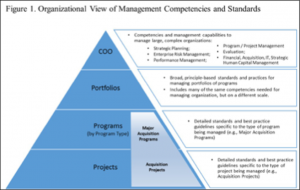Executive Summary
The purpose of this paper is to provide a comprehensive overview of the Program Management Improvement and Accountability Act along with the meaningful impact this will have on future government projects. In 2016, Project Management Institution revealed a startling statistic that only 64% of all government initiatives ever meet their intended goals and that approximately $101 million for every one billion spent on initiatives is wasted. Since funding for government initiatives comes directly from taxpayers, this statistic implies that the United States government is wasting taxpayer dollars. It should come at no surprise that this legislation passed through congress receiving bi-partisan support as all involved parties can agree that not meeting a goal is bad, however wasting taxpayer dollars while not meeting goals is worse.

INTRODUCTION
In December 2016, President Barack Obama signed an important act into law. The Program Management Improvement and Accountability Act of 2015 (PMIAA) was enacted to transform the federal government’s project and program management practices. Research completed by Project Management Institute (PMI) in their annual Pulse of the Profession, revealed that only 64% of all government projects ever meet their intended goals and that approximately $101 million for every one billion spent on initiatives is wasted. This literature review considers whether PMIAA is an effective solution for improving federal government project and program success by responding to the following questions:
- What are the main strategies outlined in PMIAA?
- How will PMIAA strategies be implemented?
- What are the risks associated with this act?
- Is this the best solution?
With evidence that ineffective project and program management across federal government agencies is wasting taxpayer dollars, a solution to address this challenge is needed.
What are the main strategies outlined in PMIAA?
Without a clear understanding of what PMIAA focuses on, there is a risk that nothing meaningful will get accomplished. On June 25, 2018, Office of Management and Budget (OMB) Director Mick Mulvaney sent out a letter to all heads of executive departments and agencies outlining the implementation of the Program Management Improvement Accountability Act. He stated that the three strategies will be coordinating governance, regular OMB and agency engagement and review, and strengthening program management capacity to build a capable P/PM workforce.
The first strategy in PMIAA is coordinated governance. The focus is on putting people with the correct experience in the correct positions and empowering them to define project and program management for their specific agency. The second main point of PMIAA’s first strategy is the appointment of a Program Management Improvement Officer for each CFO led agency. The primary mission for this appointed official will be “professionalizing agency program and project managers and enhancing the utilization of P/PM practices to build greater capability at agencies over time.”(Mulvaney, 2018, p. 5) Additionally, the PMIO will be responsible for attending the new Program Management Policy Council (PMPC) meetings bi-annually to share P/PM best practices in their agency and assist with the adoption of PMIAA across the federal government. This council is primarily tasked with overseeing implementation of PMIAA, however they are also responsible for creating and facilitating standards-based principles and trainings for federal government P/PMs. Lastly, the council will work to strengthen ties with project and program management industry leaders and organizations in an effort to instill industry best practices in the federal government processes.
(Mulvaney, 2018, p. 5)
The second strategy places an emphasis on accountability. Each agency will identify their unique portfolios and review them regularly with OMB. OMB will provide principles and guidelines for agencies to follow while preparing for these portfolio reviews. The primary goals from these portfolio reviews are to highlight successful project outcomes and share these best practices with PMPC along with identifying high-risk areas. Ultimately, portfolios and programs identified, as high risk will be placed on an action plan to address these areas and will work continuously with OMB until the portfolio or program is no longer identified as a high-risk area.
Strategy number three is about transforming the P/PM workforce. This will include the creation of a standardized job identifier and career path, which will provide a necessary organization to the federal government. Noteworthy, this strategy also places a high degree of emphasis on the creation of formal mentorship programs to ensure a smooth knowledge transfer between senior executives, program managers and project managers.
How will PMIAA strategies be implemented?
As we discussed in class, companies do not currently have a shortage of ideas or even good ideas, what they lack is the capacity to successfully execute on their good ideas. This sentiment holds true for the federal government as well. The PMIAA addresses this challenge by implementing the act’s main strategies through a phased approach. The first phase outlined establishes the foundation including people, resources and job identifiers, while the latter phases emphasize expansion of the act to various agencies. This section will focus on how the PMIAA is being implemented and what is being focused on in each phase.
Phase I of PMIAA implementation is about putting the right people in the right positions, giving them a shared set of principles and allowing them to begin defining the future of P/PM. At the forefront, the OMB is responsible for planning the biannual PMPC meetings. Next each agency must determine which official will serve as the PMIO. This person will be responsible for creating a PMIAA implementation plan and preparing for portfolio reviews with OMB. Throughout the year, agency PMIOs will present their portfolios to OMB including successes, challenges and identified risks within the portfolios. Also, OMB, the Office of People Personnel and the newly formed PMPC to strengthen and professionalize the P/PM workforce will create standards-based principles and will frequently engage with industry to review and update these principles.
In Phase II of the PMIAA implementation plan, portfolio reviews are expanded and trainings begin. Agencies are by this point expected to account for grants as part of their ongoing portfolio reviews along with “develop a methodology and criteria for conducting portfolio reviews of grants” (Mulvaney, 2018, p. 16) New trainings will also be created and standards that were originally established in Phase I will be reviewed and updated.
Phase III is expected to begin in 2022 and therefore is broader in scope at this time. Outlined in M-18-19 Phase III: Updated 5-Year Strategic Plan, Expanding Portfolio Reviews “OMB, in collaboration with the PMPC, will issue a revised 5-year strategic plan with updated strategies and path for prioritizing development of P/PM standards for additional program types.” (Mulvaney, 2018, p. 17)
What are the risks associated with this act?
Ideally, a set of policies and standards for project and program managers in the federal government can be created and implemented easily. However, due to the history of agencies managing projects, many diverse schools of thoughts around what those policies and standards should be already exists. This section focuses on three risks associated with PMIAA that could impact its effectiveness.
One risk that has been well highlighted is the need for standardized terminology. As author John Kamensky recently wrote, “There is not a one-size-fits-all definition as to what constitutes a program. There are several ways of viewing what constitutes a program, some of which are relevant to some agencies based on their missions, but no definition works across the board.” (Kamensky, 2018, para. 15) The risk is that agencies will loosely categorize what-would-be programs as other initiatives to avoid following PMIAA rules and regulations.
A second risk that exists is the current federal government P/PM workforce’s capacity and motivation to transform. Instead of viewing PMIAA as a much-needed set of guidelines the changing environment of project and program management, it can be seen as a burden. This risk is maximized by the fact that the federal government works with large, complex acquisition projects and may lack the motivation to conform its already complex projects and programs into a mold for PMIAA standards.
As we discussed in class, risk is a neutral word in project management and therefore a positive risk, otherwise known, as an opportunity can exist. The last risk associated with the PMIAA implementation is that the federal government can save billions of taxpayer dollars. With a shared set of standards-based principles, and a shared motivation to transform the careers of project and program managers across the federal government, billions of dollars can be saved through process improvements and better utilization of resources.
Is this the best solution?
Project and program management has evolved as a practice in large part due to volunteers across the globe that contributes knowledge and best practices to the community. This includes research by multinational organizations like Project Management Institute. Due to the fact that PMIAA was designed in collaboration with Project Management Institute and P/PM experts, I believe it is the best solution. In this section, I will demonstrate how one agencies commitment to change produced meaningful results and discuss two recommendations for driving results across the federal government.
The benefits of conforming to a standardized set of principles for project and program management can be seen in the Department of Energy, Energy Information Administration case study available through PMI. This department is responsible for creating and distributing unbiased energy data for the public. In 2015 after an internal review of their programs, they uncovered that they were not operating efficiently. This discovery launched a project to create a formal PMO. “EIA staff faced a significant challenge with identifying a suitable PMO framework that would fit the organization’s strategic need. Recognizing the path forward as an evolutionary journey rather than a one-step implementation, EIA staff needed a pathway that defined the implementation steps and quantified the sustainment of transformational change.” (PMIAA: Strengthening the Government Delivery Foundation 2019, p. 12) The agency tailored their approach to project and program management to fit their needs. The results of their efforts were the production of standardized project practices for their agencies, relevant trainings created and distributed and strategic projects better monitored for senior leadership. This is a good example of how the organization was able to enhance the quality of their deliverables, formalize communication and reporting standards and lastly monitor and decrease their costs.
What can result from successful implementation of PMIAA includes decreasing the amount of projects that go over budget; better defining project scope and better schedule management while increasing workforce quality. A significant challenge I see in actualizing these results is properly defining program across the federal government agencies. Due to the complexity associated with creating a single definition for program, my first managerial recommendation is that the federal government instead defines a set of values for project and program managers. If shared values can be agreed upon, then these values can be used for making tough decisions such as how an agency defines a program. If decisions are being made based on values, then a project or program manager can always be transparent in her/his decision-making process.
My last recommendation for successfully implementing PMIAA is for federal project and program managers to engage deeply with the industry community. This should include creating reports and sharing best practices at conferences and annual summits, seeking opportunities to collaborate with the private sector and most importantly comparing project results and hours used vs. industry averages for similar projects and tasks. Through a commitment from the federal government to transform and professionalize project and program management practices, I believe PMIAA will have a significant impact on how taxpayer dollars are utilized.
Biography:
Nicholas Cruz attends Montclair State University studying Project Management. He is a member of the Project Management Institute New Jersey chapter. Nicholas has completed an entrepreneurship workshop at The Advanced Technology Development Center (ATDC) at Georgia Tech and a design sprint with Three Five Two innovation firm in Atlanta, Georgia.
Learn more about the author here: https://www.linkedin.com/in/nicholasjcruz/


Recent Comments